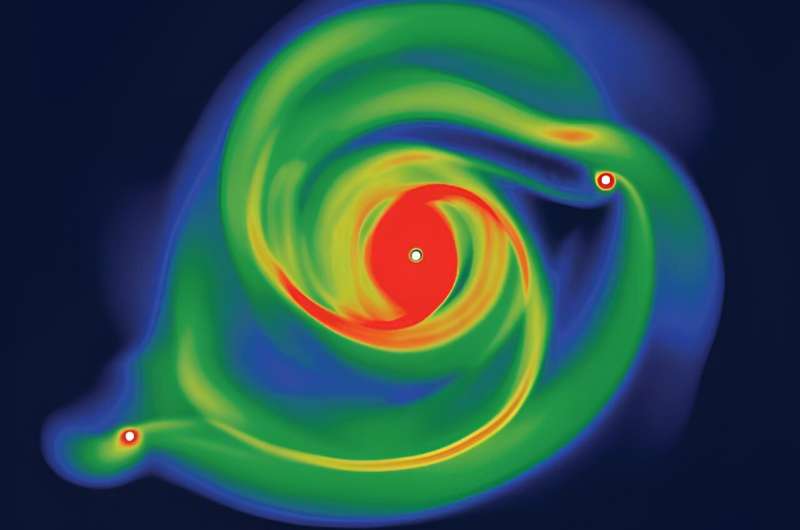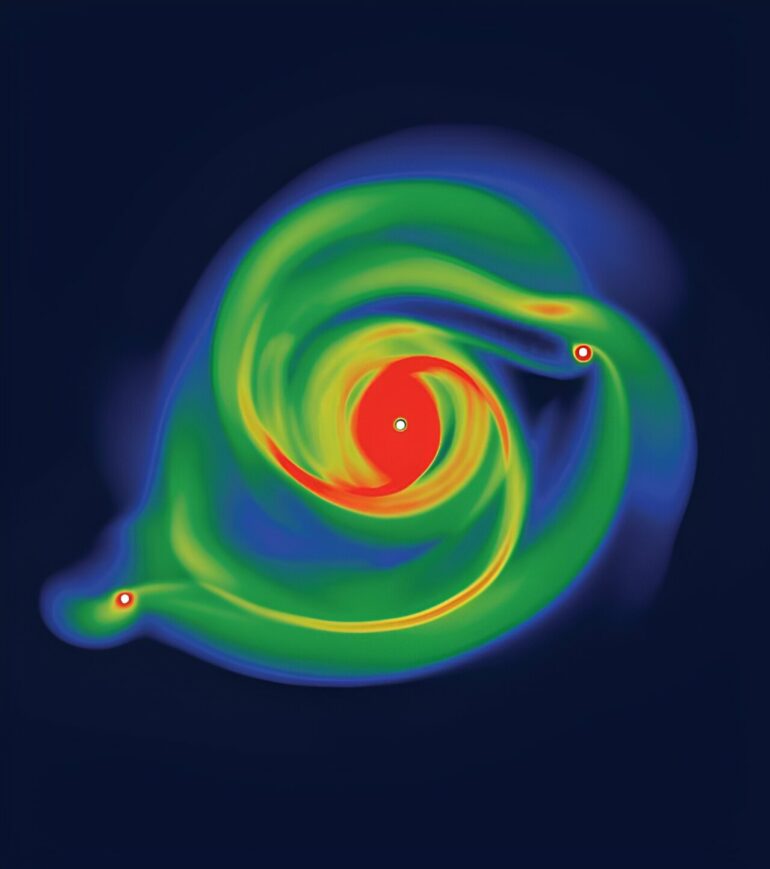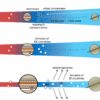Astrophysicists from the University of Central Lancashire (UCLan) have found that planets have flattened shapes like smarties just after they form rather than being spherical as previously thought.
The research, accepted for publication in Astronomy & Astrophysics Letters, shows that protoplanets, which are very young planets recently formed around stars, are flattened structures called oblate spheroids. The paper can currently be accessed on the arXiv preprint server.
The team, from UCLan’s Jeremiah Horrocks Institute for Mathematics, Physics and Astronomy, used computer simulations to model the formation of planets according to the theory of disk-instability, which suggests that protoplanets form in short timescales from the breaking up of large rotating disks of dense gas orbiting around young stars.
Taking this approach, the team determined planet properties, compared them with observations and examined the formation mechanism of gas giant planets. They focused on investigating the shapes of young planets and on how these planets may grow to become large gas giant planets, even larger than Jupiter. They also examined the properties of planets forming in a variety of physical conditions, such as ambient temperature and gas density.
Dr. Adam Fenton, a recently graduated Ph.D. student, led the research. He said, “Many exoplanets, which are planets that orbit stars in other solar systems outside of our own, have been discovered in the last three decades. Despite observing many thousands of them, how they form remains unexplained.
“It is believed that they either form through ‘core accretion,’ which is a gradual growth of dust particles that stick together to form progressively larger and larger objects on long timescales, or directly by the breaking up of large rotating protostellar disks around young stars in short timescales, which is what we call the theory of disk-instability.
“This theory is appealing due to the fact that large planets can form very quickly at large distances from their host star, explaining some exoplanet observations.
“It was an extremely demanding computational project requiring half a million CPU hours on the UK’s DiRAC High Performance Computing Facility. But the results were amazing and worth the effort.”

Computer simulation of planets forming in a protostellar disc. © arXiv (2024). DOI: 10.48550/arxiv.2402.01432
Dr. Dimitris Stamatellos, Reader in Astrophysics at UCLan and co-investigator, said, “We have been studying planet formation for a long time but never before had we thought to check the shape of the planets as they form in the simulations. We had always assumed that they were spherical.
“We were very surprised that they turned out to be oblate spheroids, pretty similar to smarties.”
Observational confirmation of the flattened shape of young planets may answer the critical question about how planets form, pointing towards the currently less-favored disk-instability model rather than the standard planet formation theory of core accretion.
The researchers also discovered that new planets grow as material falls onto them, predominately from their poles rather than their equators.
These findings have important implications for observations of young planets as they suggest that the way planets appear through a telescope depends on the viewing angle. Such observations of young planets are important in order to understand the planet formation mechanism.
The researchers are following up this discovery with improved computational models to examine how the shape of these planets is affected by the environment in which they form, and to determine their chemical composition to compare with future observations from the James Webb Space Telescope (JWST).
Observations of young planets have become possible in the last few years with observing facilities such as the Atacama Large Millimeter Array (ALMA) and the Very Large Telescope (VLT).
More information:
Adam Fenton et al, The 3D structure of disc-instability protoplanets, arXiv (2024). DOI: 10.48550/arxiv.2402.01432
Provided by
Astronomy & Astrophysics
Citation:
New research finds that young planets are flattened structures rather than spherical (2024, February 5)



